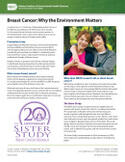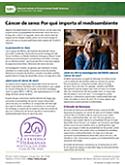Introduction

About 12%, or 1 in 8, women in the U.S. will develop breast cancer during their lifetime. It is the second most common cancer among U.S. women, behind skin cancer.1 Breast cancer occurs mostly in women who are 50 years old or older. But men can also develop the disease. Each year in the U.S., about 245,000 cases of breast cancer are diagnosed in women and about 2,200 in men.2
Breast cancer is a disease in which cells in the breast grow out of control and may form a tumor. There are different kinds of breast cancer. If the cancerous cells spread to other parts of the body, the disease is called metastatic breast cancer.
Although scientists have identified many risk factors that increase a woman’s chance of developing breast cancer, they do not yet know what causes normal cells to become cancerous. Experts tend to agree that breast cancer is caused by a combination of genetic, hormonal, and environmental factors.
Breast Cancer and the Environment
Most women who develop breast cancer have no family history of the disease, suggesting an environmental link.
Both the President’s Cancer Panel and the Interagency Breast Cancer and Environment Research Coordinating Committee have reported on the mounting literature demonstrating connections between exposures to environmental toxicants and later development of disease, including breast cancer. They have also prioritized prevention as an aim for both research and public health practice. A 2017 state of the evidence publication reinforces the conclusion that exposures to a wide variety of toxicants, many found in everyday products, can lead to an increased chance of developing breast cancer.
NIEHS scientists and other experts believe prevention strategies are the best way to try to stop breast cancer before it starts.
-
American Cancer Society. 2018. Breast Cancer [accessed December 3, 2018]. [Available American Cancer Society. 2018. Breast Cancer [accessed December 3, 2018].]
-
Centers for Disease Control and Prevention - Breast Cancer Basic Information [Available Centers for Disease Control and Prevention - Breast Cancer Basic Information]
What is NIEHS Doing?
NIEHS plays a leadership role in funding and conducting studies on the ways in which genetic and environmental factors may affect breast cancer risk. Research can help determine environmental exposures that are linked to breast cancer. Then, reducing those exposures may help prevent disease.
For example, NIEHS scientists discovered women living in areas with higher levels of air pollution may have a higher risk of breast cancer. Another study looked at a component of air pollution called fine particulate matter and found an association with breast cancer. This study considered past air pollution over a couple of decades, which is important because some cancers develop over time. Fine particulate matter in the air comes from numerous sources, such as combustion processes (for example, oil, gas, and coal), tobacco smoke, wildfires and vegetation burning, and industrial emissions. These particles are small enough to be inhaled deep into the lungs.
NIEHS Sister Study
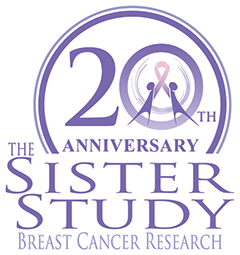
The NIEHS Sister Study includes more than 50,000 sisters of women with breast cancer from the U.S., including Puerto Rico. The study looks at lifestyle and environmental exposures, as well as genetic and biological factors that may affect a woman’s chance of developing breast cancer. A wealth of data on exposures, including biological samples, allows the team to address many questions relating to factors associated with disease.
Women with sisters who had breast cancer may have genetic profiles that make them twice as likely to develop breast cancer themselves. The study design offers the ability to identify environmental exposures over the life course that increase the chance of developing breast cancer, and to identify how genes and the environment interact to increase risk. In addition to breast cancer, the Sister Study has discovered other important information related to women’s health.
The Sister Study commemorates its 20th anniversary in 2023. Some findings from this study follow:
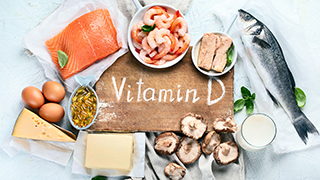
Diet and Exercise - Vitamin D may protect against breast cancer, including Black/African American and non-Black Hispanic/Latina women. NIEHS researchers found women with low vitamin D levels have a higher risk of breast cancer than those with sufficient vitamin D levels. And postmenopausal women who had higher levels of vitamin D in their blood or who reported taking vitamin D supplements at least four times a week had lower rates of breast cancer.
In women with a family history of breast cancer, physical activity (7 or more hours per week) was associated with reduced breast cancer risk in postmenopausal women.

A large analysis that pooled data from several studies, including the Sister Study, found that regular leisure-time physical activity may reduce the risk of breast cancer for women before menopause. Such activity includes walking, cycling, and playing sports. This finding adds to evidence that women who are more physically active may reduce their premenopausal breast cancer risk.
Air Pollution - Sister Study researchers found that women who lived in areas with higher levels of lead, mercury, and cadmium in air pollution had a greater chance of developing postmenopausal breast cancer. They also found that higher levels of nitrogen dioxide (NO2), a component of air pollution related to traffic, was associated with increased breast cancer risk.
Radon gas, which occurs naturally in the environment, can break down into radioactive particles that can mix with air pollutants. Researchers found that exposure to these airborne radioactive particles was associated with a higher risk of estrogen receptor-negative breast cancer.
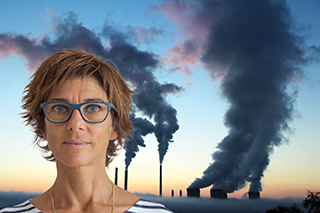
Researchers evaluated whether dioxins in the air may be associated with breast cancer risk. Publicly available data on industrial emissions at facilities located near participants’ homes were used to estimate dioxin exposure levels. They found that long-term exposure to airborne dioxin emissions within 2 miles of participants’ residences was associated with increased breast cancer risk. This association was strongest for emissions from municipal solid waste facilities. This finding indicates that living in proximity to industrial emissions may be linked to higher breast cancer rates.
Indoor air quality is another concern. Burning wood or natural gas indoors, at least once a week, was associated with a modestly higher risk of breast cancer.
Hair Products - Another interest area for Sister Study researchers, these products have potential for long-term health effects due to certain chemicals in them.
Women who regularly used hair straighteners and dye were 9% more likely than women who did not to develop breast cancer. Among Black women, using permanent dyes every five to eight weeks or more was associated with a 60% increased chance of developing breast cancer, as compared with an 8% increased risk for white women.
Researchers looked at hair product use during adolescence and found that frequent use of straighteners and perms may be associated with increased breast cancer risk later in life, particularly prior to menopause. This research suggests that some chemicals in such products may be harmful to health, even when used decades before.
Breast cancer genetic risk often refers to how the genes a woman is born with can influence her chance of getting breast cancer. However, as researchers showed, breast cancer may also be affected by naturally occurring changes to DNA, known as methylation, that occur after birth. Women who developed breast cancer after joining the study were more likely to have changes in DNA methylation than those who did not have breast cancer, as seen in blood samples collected for the study.
A risk prediction score may improve how women who are at higher risk for developing breast cancer can be identified. This risk score is based on individual changes to DNA methylation associated with breast cancer risk, as well as multiple DNA methylation clocks associated with aging, morbidity and mortality risks, as well as breast cancer. Though this method returned promising results, further investigation and replication is needed to see if it will be useful in a clinical setting.
Chronological age is a leading risk factor for breast cancer. NIEHS scientists found that measures of biological aging based on combinations of DNA methylation changes, known as methylation-age clocks, may be tied to environmental exposures and the likelihood of developing breast cancer. The researchers later found that women who received breast cancer treatment, particularly radiation therapy, were biologically older than women who were never diagnosed with breast cancer.
Nighttime light, from inside the bedroom or shining in from outside the residence, is thought to increase the risk of breast cancer by disrupting the body’s natural 24-hour (circadian) rhythms, which serve a wide variety of biologic functions. Sleeping with a television on, or at least one light on in the bedroom, was associated with a small (9%) increase in breast cancer risk.
Future Direction for the Sister Study
The Sister Study collects more detailed information than many other studies, allowing researchers to ask and answer more complicated questions. They have been able, and will continue, to partner with researchers all over the world. Participants in the study are diverse, which allows researchers to study the health effects of factors related to where someone lives. A newer challenge is to understand how changes in the climate may affect breast cancer risk. For example, the researchers are studying the effects of heat and how stressors from experiencing natural disasters may relate to breast cancer risk. They also are focusing more on the ways that environmental factors may affect how well women fare after diagnosis and treatment for breast cancer.
Fact Sheets
Breast Cancer: Why the Environment Matters
Cáncer de seno: por qué importa el medio ambiente?
Two Sister Study
An offshoot of the Sister Study, this study focuses on breast cancer in women younger than 50, who may have different breast cancer risk factors than older women. Approximately 1,300 women with young-onset breast cancer are participating, along with their sisters from the Sister Study and their biological parents. Some results from the study include the following.
- A 2020 study observed that women who drank at least five cups of green or black tea per week, as compared to not drinking any tea, were less likely to develop breast cancer. The reported association did not vary according to menopausal status or body weight and height. The results should not be interpreted as meaning tea drinking can prevent breast cancer.
- Red meat consumption may increase the risk of invasive breast cancer, whereas poultry consumption may be associated with reduced risk. Substituting poultry for red meat could reduce breast cancer risk.
- Diets that create a higher acid load (associated with meat protein and grains) in the body may be a risk factor for breast cancer, while diets that create an alkaline load (associated with vegetables and fruits) may be protective against hormone receptor negative breast cancer.
- Women who took estrogen-only hormone therapy had a 42% decrease in their risk of young-onset breast cancer, compared to their sisters who never had hormone therapy.3
- Three novel single nucleotide polymorphisms, or genetic variation, were associated with the disease in younger women.4
More NIEHS Research
NIEHS continues to fund grants for breast cancer research. For example, grant recipients are studying:
Breast Cancer and the Environment Program (BCERP)
Jointly funded by NIEHS and the National Cancer Institute, grant-funded researchers and community organizations worked together through BCERP to discover environmental factors that may contribute to breast cancer. This program, which began in 2003 and wound down by 2020, was one of the first at NIEHS to require transdisciplinary expertise. It used a team science approach, including toxicology, epidemiology, environmental health, biostatistics, and communication, to address research questions and facilitate community engagement.
An overarching concept from BCERP is that the influence of environmental chemicals on breast cancer risk may be greater during certain windows of susceptibility in a woman’s life, including prenatal development, puberty, pregnancy, and the menopausal transition. By focusing on environmental chemical exposure during specific periods when breast tissue changes, we may identify when prevention efforts are more likely to be effective.
Some hallmark findings from BCERP follow.

- The chance of developing breast cancer is increased with exposure to endocrine disrupting chemicals during these periods in a woman's life: her prenatal development, puberty, pregnancy, and menopausal transition.5
- Exposures to common contaminants in the environment may change the timing of puberty. For example, girls exposed to high levels of triclosan, a chemical used in antimicrobial soaps, experienced early breast development. Also, girls exposed to high levels of benzophenone-3, found in some sunscreens, experienced later breast development.6
- Proteins produced by developing mammary tissue may change after exposure to bisphenol A, a chemical found in many plastic products, and other pollutants in the environment. These exposures may alter cells in ways that contribute to breast cancer.
- DDT exposure during pregnancy may alter certain genes leading to an increased chance of developing breast cancer in the daughters of those women.
NIEHS continues to fund grants for breast cancer research. For example, grant recipients are studying:
- Why African American women are more likely to get aggressive forms of breast cancer than other women.
- How disrupting a woman’s biological clock or circadian rhythm (through shift work or time zone changes, for example) can affect the risk of developing breast cancer.
- How chemicals like PFAS may affect the chance of developing breast cancer.
National Toxicology Program (NTP)
An interagency program headquartered at NIEHS, NTP lists six substances in the Report on Carcinogens because they cause or may cause breast cancer in humans: diethylstilbestrol (DES), a synthetic estrogen that was used to prevent miscarriages; steroidal estrogens used for menopausal therapy; X-ray and gamma radiation; alcoholic beverages; tobacco smoking; and ethylene oxide, a sterilizing agent.
After conducting cancer assessments for working at night, NTP found that persistent night shift work that disrupts circadian rhythms can cause breast cancer in women. This type of work is considered frequent and long-term, especially beginning in early adulthood.
-
O’Brien KM, Fei C, Sandler DP, Nichols HB, DeRoo LA, Weinberg CR. 2015. Hormone therapy and young-onset breast cancer. Am J Epidemiol 181(10):799-807. [Abstract O’Brien KM, Fei C, Sandler DP, Nichols HB, DeRoo LA, Weinberg CR. 2015. Hormone therapy and young-onset breast cancer. Am J Epidemiol 181(10):799-807.]
-
O’Brien Shi M, Sandler DP, Taylor JA, Zavkin DV, Keller J, Wise AS, Weinberg CR. 2016. A family-based, genome-wide association study of young-onset breast cancer: inherited variants and maternally mediated effects. Eur J Hum Genet 24(9):1316-1323. [Abstract O’Brien Shi M, Sandler DP, Taylor JA, Zavkin DV, Keller J, Wise AS, Weinberg CR. 2016. A family-based, genome-wide association study of young-onset breast cancer: inherited variants and maternally mediated effects. Eur J Hum Genet 24(9):1316-1323.]
-
Terry MB, et al. 2019. Environmental exposures during windows of susceptibility for breast cancer: a framework for prevention research. Breast Cancer Research; doi: 10.1186/s13058-019-1168-2 [Online 20 August 2019]. [Abstract Terry MB, et al. 2019. Environmental exposures during windows of susceptibility for breast cancer: a framework for prevention research. Breast Cancer Research; doi: 10.1186/s13058-019-1168-2 [Online 20 August 2019].]
-
Wolff MS, Teitelbaum SL, McGovern K, Pinney SM, Windham GC, Galvez M, Pajak A, Rybak M, Calafat AM, Kushi LH, Biro FM, Breast Cancer and Environment Research Program. 2016. Environmental phenols and pubertal development in girls. Environ Int 84:174-180. [Abstract Wolff MS, Teitelbaum SL, McGovern K, Pinney SM, Windham GC, Galvez M, Pajak A, Rybak M, Calafat AM, Kushi LH, Biro FM, Breast Cancer and Environment Research Program. 2016. Environmental phenols and pubertal development in girls. Environ Int 84:174-180.]
Further Reading
Stories from the Environmental Factor (NIEHS Newsletter)
- Ask the Expert: Can Moderate Physical Activity Reduce Breast Cancer Risk? (January 2024)
- Why Breast Cancer Incidence Varies Across the United States (January 2024)
- Advances in Breast Cancer Research Shared With NIH and the World (October 2023)
- Air Pollution Associated With Increased Breast Cancer Incidence (October 2023)
- Air Pollution May Affect Breast Tissue Composition, Cancer Risk (July 2023)
- Role of Complex Exposures in Breast Cancer Highlighted During Workshop (October 2022)
- Vitamin D May Protect Against Breast Cancer in Black, Hispanic Women (August 2022)
- Stress Hormones’ Role in Breast Cancer Illuminated by NIEHS Research(February 2022)
- Increasing Evidence Links Air Pollution With Breast Cancer (November 2021)
- New Breast Cancer Risk Score Developed by NIEHS Scientists (October 2021)
Press Releases
- High Levels of Particulate Air Pollution Associated With Increased Breast Cancer Incidence (September 11, 2023)
- Women Treated for Breast Cancer May Age Faster Than Cancer-Free Women (July 19, 2023)
- Permanent Hair Dye and Straighteners May Increase Breast Cancer Risk (Dec. 4, 2019)
Additional Resources
- Mammograms - Information by the Office of Women’s Health, U.S. Department of Health and Human Services.
- National Cancer Institute - Facts, risk factors, diagnosis, and treatment of breast cancer.
- Centers for Disease Control and Prevention - Basic information about low-cost screening, treatment plans, statistics, and other resources related to breast cancer.
- National Library of Medicine - Research, genetics, causes and prevention, and other helpful information.
Related Health Topics
This content is available to use on your website.
Please visit NIEHS Syndication to get started.


